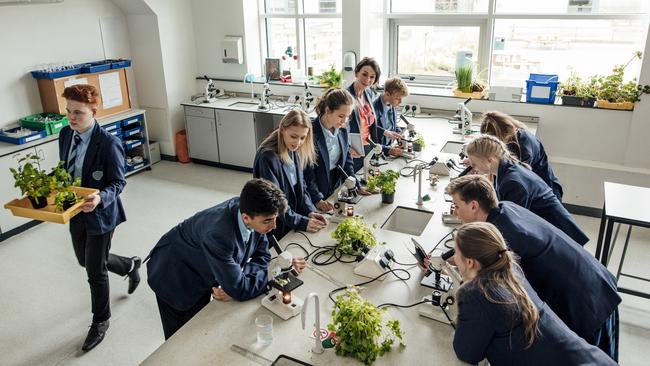New figures reveal the true completion rate of Year 12s in South Australia
CLOSE to half of Year 12s in the public system do not complete their SACE in that year, and more than a quarter leave with neither the high school certificate nor a school-based vocational qualification.
SA News
Don't miss out on the headlines from SA News. Followed categories will be added to My News.
CLOSE to half of Year 12 students in the public system do not complete their SACE in that year, and more than a quarter leave with neither the high school certificate nor a school-based vocational qualification.
The State Government has provided The Advertiser with data that for the first time lays bare the scale of the challenge public high schools face in raising academic achievement.
Education Minister John Gardner says the Government will commission independent research to find out what happens to the thousands of students who leave the public system “without a known educational outcome”.
Despite the former Labor government claiming it had no accurate data on SACE completion, an Education Department report dated August 2017 says 55 per cent of Year 12s leave with their SACE.
Most of the rest exit without the qualification while a minority repeat, but completion rates among Year 13s are extremely low, around 15 per cent.
The report reveals that barely half of the 11,700-strong Year 8 cohort from 2012 – around 6000 students – went on to complete the SACE in the public system, though some of the others would have completed after shifting to private schools.
The data confirms The Advertiser ’s revelation in June, via a leaked department document, that only 60 per cent of students who begin the SACE through the Personal Learning Plan, usually done in Year 10, go on to complete the SACE. The rate is 34.5 per cent for the most disadvantaged category of schools.
New figures also show that 3736 Year 12/13 students, or 27 per cent, had an “unknown” education outcome in 2016 as they neither completed the SACE nor participated in vocational training.
Mr Gardner said it was unclear whether they had transitioned into employment or further education and training outside of school.
“Clearly we need to gain a better understanding of why some students are slipping through the cracks,” he said.
“The SACE attainment rates identified in this (analysis) present a set of challenges not readily
acknowledged by the former government.
“The Liberal Government believes that it is critically important to address these issues.”
The analysis was delivered by new data sharing between the Education Department, the SACE Board and the Industry and Skills Department.
Mr Gardner said the Government would establish new research partnerships with universities or other organisations for a “learning and earning” project to understand the choices students make and roles that schools play in them. An expression of interest process will begin next month.
“This research will help us understand the barriers and incentives that are influencing students in making their life choices, and what schools can be doing to facilitate young people into meaningful study or employment,” Mr Gardner said.
“We are committed to delivering educational outcomes that lead to further study, vocational pathways and real jobs.”

Flinders University’s Dr Andrew Bills, who previously obtained reports showing SACE completion rates for students special programs for at-risk teens were as low as one in 20, welcomed the transparency.
“You can’t shy away from the data because it’s impacting the lives of thousands of kids,” he said.
“If you hide it away you can’t deal with the problem. If this isn’t addressed it will cost the state millions in terms of welfare, housing provision and so on.”
Dr Bills said the learning and earning project was “what we’ve been hoping for … for three years” and was needed to unravel “the multifarious effects of disadvantage and poverty”.
Comparisons with other states are difficult as most publicly available data from state-based assessment authorities combines public and private schools. The Australian Bureau of Statistics said it only tracked enrolments, while Productivity Commission data is not comparable across states as different measures are used - for example, “Year 12 attainment” for SA is defined as any student who completes one Stage 2 SACE subject.
The Advertiser first highlighted the SACE completion issue in late 2016, roughly calculating that more than a third of teens were not attaining the certificate by comparing Year 10 enrolments with completers two years later.
On the eve of the state election in March, Labor said it couldn’t provide more than its own crude calculation based on a comparison of birthrates with graduates.
In June this year, former Labor education minister Susan Close said the Education Department had likely been “holding off” releasing more detailed figures on SACE completion until it had more accurate numbers and better understanding of factors behind them.

FAILING TO FINISH
■ Last year, the SACE achievement rate among Year 12/13s rose slightly to 57 per cent (7814 students from 13,774 Year 12/13 enrolments).
■ That is far below the SACE Board’s completion rate measure, which was 94.4 per cent in 2016. That measures the proportion of “potential completers” in a given year – those enrolled in enough subjects to complete the SACE – with those who finish.
■ An Education Department report states: “A large proportion of students are making it into Year 12 but not completing the SACE.”
■ The department says 10-15 per cent of Year 8 students will shift to private schools, or head interstate or overseas, by the end of Year 12.
■ The Personal Learning Plan marks the start of the SACE, usually done in Year 10. Sixty per cent of students who do the PLP go on to complete their SACE.
■ In 2016, of 10,906 students who had previously done the PLP, 6518 attained their SACE, while 4388 did not.
■ 25-30 per cent of any Year 8 intake – up to 4000 students – are not on a SACE pathway by the end of secondary school.
■ In 2016, 76 per cent of Year 11s progressed to Year 12. A majority of the rest left the school system. About 2400 left school completely, while about 1000 enrolled in private schools or repeated Year 11.
■ From 2012-16, that transition rate of Year 11 to Year 12 has risen from 70 to 76 per cent.
■ 74 per cent of the 2012 public school Year 8 cohort was still enrolled in an SA public school four years later, although not all at Year 12 level.
■ The department says high student turnover between year levels adds complexity to tracking student pathways and outcomes.
SECRECY SETS A BAD EXAMPLE FOR STUDENTS
Analysis — Tim Williams
IT shouldn’t have been so hard to get a straight answer on such an important issue.
The Advertiser began asking about SACE completion rates nearly two years ago, calculating more than a third of kids weren’t getting there.
At the time, the Education Department said it was looking into the issue, including how many students weren’t even attempting the SACE.
We kept asking periodically throughout last year, and again just before the state election in March. Former minister Susan Close wouldn’t offer more than her own back-of-an-envelope calculation, which one parent group said was “unfathomable”. Unsurprisingly, that calculation was a bit more flattering than ours.
It turns out the department produced a report in August last year on SACE completion in public schools, but the Government kept it secret. It shows barely more than half of students who make it to Year 12 – and lots don’t get that far – finish their SACE in that year.
Why does it matter? Because, while there are exceptions to the rule, people who finish Year 12 fare better in life than those who don’t. It’s estimated each disengaged young person costs taxpayers $1 million over their lifetime.
The Liberals’ release of the department’s report is welcome, as is the commitment to a research project to find out what happens to the thousands of kids with “unknown” educational outcomes.
But transparency early in the electoral cycle is easy, when problems can be blamed on the previous government.
The bigger challenge for the Marshall Government is to fix this disgrace.


